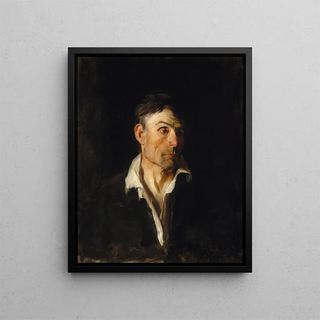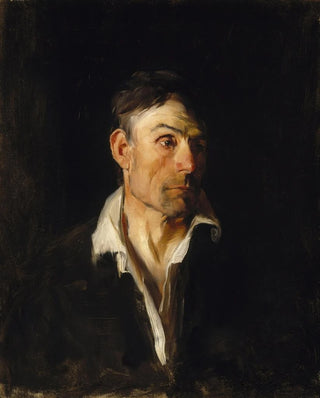Painting Portrait of a Man - Frank Duveneck | Art print


View from behind

Frame (optional)
Portrait of a Man - Frank Duveneck – Captivating Introduction
The "Portrait of a Man" by Frank Duveneck is a work that transcends the simple frame of painting to establish itself as a living testament to an era where art and life intertwine. This painting, created at the end of the 19th century, captures the very essence of its subject with an intensity that leaves no one indifferent. Immersing oneself in this piece, one is immediately transported to a world where the gaze of the portrayed man seems to tell a story, an intimate and universal narrative at once. Light plays a leading role, enveloping the character in an almost mystical aura, while shadows add a striking depth to the whole. This art print allows for a rediscovery of Duveneck's art in a new light, while offering a window into the past.
Style and uniqueness of the work
Frank Duveneck's style is characterized by a realistic approach, yet not devoid of sensitivity. In the "Portrait of a Man," the artist manages to capture not only the physical features of his model but also a certain psychology, a soul. The texture of the paint, rendered with remarkable mastery, gives the canvas a tactile dimension. The brushstrokes, both vigorous and delicate, create a fascinating balance between strength and finesse. Every detail, from the fold of the clothing to the expression on the face, contributes to a visual narration that invites the viewer to question the identity and emotions of the depicted man. This art print stands out for its humanism, reflecting an era when the individual took a central place in art, and portraits became mirrors of aspirations and struggles.
The artist and his influence
Frank Duveneck, an emblematic figure of the American realist movement, knew how to mark his era with his unique vision of painting. Born in Cincinnati in 1848, he was influenced by European masters but also developed a style that is entirely his own. His stay in Venice, where he was exposed to the vibrant light and colors of the lagoon, profoundly impacted his work. Duveneck was not only a talented painter but also an influential teacher, shaping an entire

Matte finish

View from behind

Frame (optional)
Portrait of a Man - Frank Duveneck – Captivating Introduction
The "Portrait of a Man" by Frank Duveneck is a work that transcends the simple frame of painting to establish itself as a living testament to an era where art and life intertwine. This painting, created at the end of the 19th century, captures the very essence of its subject with an intensity that leaves no one indifferent. Immersing oneself in this piece, one is immediately transported to a world where the gaze of the portrayed man seems to tell a story, an intimate and universal narrative at once. Light plays a leading role, enveloping the character in an almost mystical aura, while shadows add a striking depth to the whole. This art print allows for a rediscovery of Duveneck's art in a new light, while offering a window into the past.
Style and uniqueness of the work
Frank Duveneck's style is characterized by a realistic approach, yet not devoid of sensitivity. In the "Portrait of a Man," the artist manages to capture not only the physical features of his model but also a certain psychology, a soul. The texture of the paint, rendered with remarkable mastery, gives the canvas a tactile dimension. The brushstrokes, both vigorous and delicate, create a fascinating balance between strength and finesse. Every detail, from the fold of the clothing to the expression on the face, contributes to a visual narration that invites the viewer to question the identity and emotions of the depicted man. This art print stands out for its humanism, reflecting an era when the individual took a central place in art, and portraits became mirrors of aspirations and struggles.
The artist and his influence
Frank Duveneck, an emblematic figure of the American realist movement, knew how to mark his era with his unique vision of painting. Born in Cincinnati in 1848, he was influenced by European masters but also developed a style that is entirely his own. His stay in Venice, where he was exposed to the vibrant light and colors of the lagoon, profoundly impacted his work. Duveneck was not only a talented painter but also an influential teacher, shaping an entire
12,34 €






